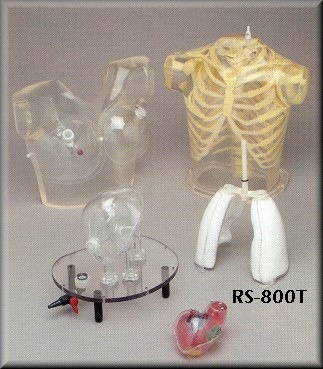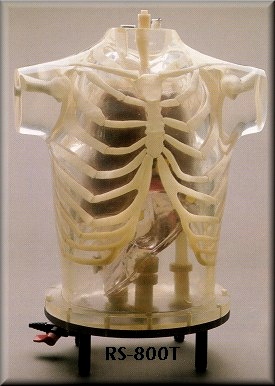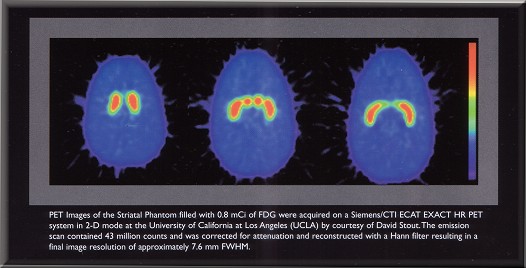 |
|
 |
|

| Nuclear Medicine Heart/Thorax Phantoms. |
 |  HEART/THORAX PHANTOM (Includes items RS-801 through RS-810)
HEART/THORAX PHANTOM (Includes items RS-801 through RS-810)The Heart/Thorax Phantom is ideal for evaluation of detectability, extent and severity of myocardial infarets in patients. This Phantom also provides valid assessment of mammoscintigraphy techniques. The Striatal Phantom optimizes quantitative imaging in patients, using PET or SPECT. The currently used attenuation, scatter and resolution correction methods are suboptimal, since they do not provide improvement in the 25% false-negative findings in a group of about 100 patients with luminal diameter stenoses of at least 50%. Furthermore, the ability to detect multivessel disease was 70% without and 47% with corrections. This finding implies that mycoardial SPECT can seriously underestimate the extend of disease in high-risk patients. On the other hand, the false-positive findings in the group with a low probability of coronary disease were reduced from 14% without corrections to 3% with corrections. Obviously, further inprovements in both hardware and software for myocardial SPECT are necessary before this important diagnostic technique can realize its full potential. These improvements must be carefully evaluated on realistic, anthropomorphic phantoms to improve results in clinical practice. The skeleton, embedded in the soft tissue, extends from the suprasternal notch down to L2. The Fluke Biomedical phantom |
| materials closely meet the standards of the International Commission on Radiation Units and Measurement (ICRU) Report
No. 44 (Tissue Sub-stitutes in Radiation Dosimetry and Measurement, 1989) for both the cortical and spongiosa components
of the human skeleton. The mass densities are 1.88 g/cc for cortical bone and 1.16 g/cc for spongiosa.
The narrow beam linear attenuation coefficient for the cortical component, measured at 140 keV is 0.280 cm-1. The volume of the thoracic cavity, when all organs (heart, lungs and liver) are inserted, is about 8,200 ml. It is filled from the top, with either an inert or a radioactive solution, to simulate the thoracic background. A valve is installed at the base for conveniently draining the phantom. The residue on the walls of the cavity can be easily flushed with the fittings provided at the top of the phantom. A second, smaller fitting is also provided as an air-bleed during filling. The left and right chambers are connected at the atrium region to make a single compartment which can be filled and flushed independently using two ports labeled HC (heart chambers). The right ventricle is slightly modified to allow air to escape during filling. The myocardial wall (MW) has two ports, flushing and independent filling. The volume of the heart chambers is 284 ml, while the volume of the myocardial wall is 238 ml, without inserted defects. The standard model includes three defects with volumes of 8.9, 13.5 and 41.7 ml, respectively. Each of the defects can be filled separately. Defects of different dimensions can be ordered at no added cost. A disassembled heart is sent on request, so that dimensions of a special set can be established. Note that different defects cannot be retrofitted in the assembled heart. |  |
 | The volume of each vacuum-formed breast is 972 ml. A tumor, filled with a radioactive solution can be inserted to evaluate the planar and tomographic imaging techniques used for mammoscintigraphy. A set of breast tumors 3, 6, 9, 12, and 15 mm diameters) is included. They are supported by thin, threaded nylon rods which pass through ports and are sealed by o-rings. They can be bent by hand to reach any part of a breast. The thorax is mounted on a base plate with an o-ring seal. Four rubber feet provide space under the phantom for drain fittings. The base plate is removed readily to provide access to the interior of the phantom. |
|
 |
|